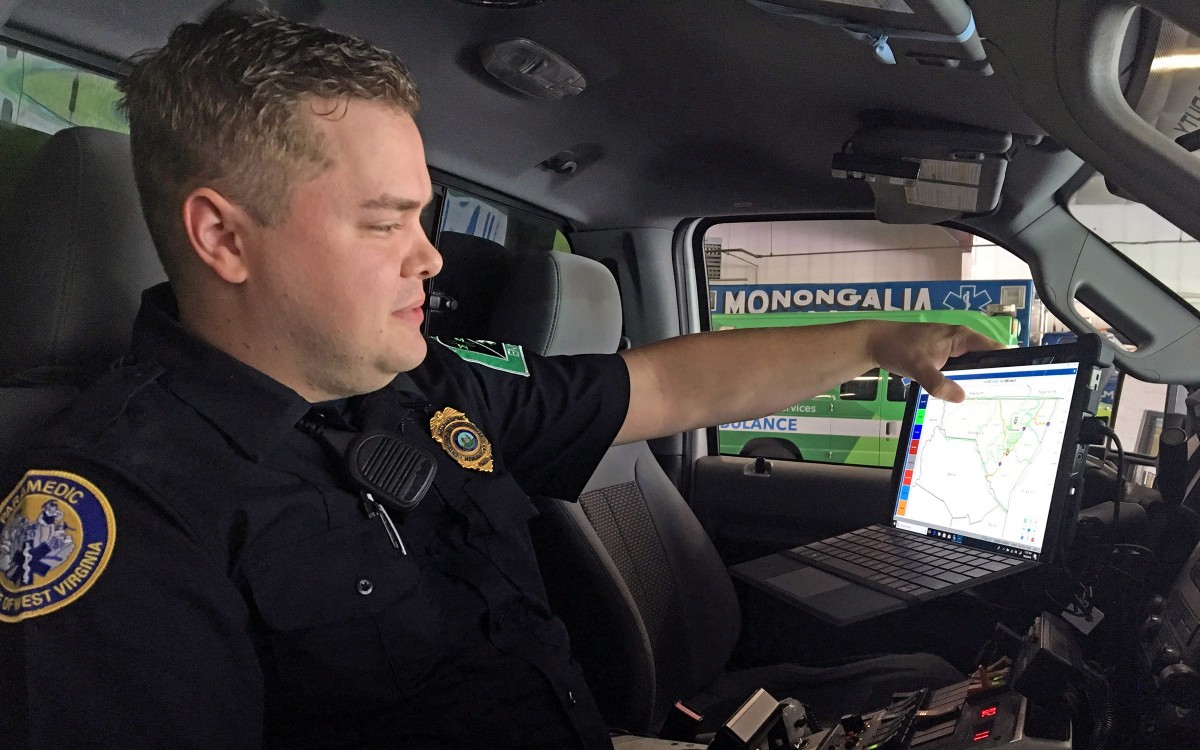MORGANTOWN — Mon Health EMS Director Dave Custer said his agency is leading the push to get the county’s four ambulance agencies synched up to MECCA 911’s global positioning system (GPS) by the end of the year.
On Thursday, Mon Health EMS opened up its JD Anderson Drive facility to demonstrate the Zuercher GPS hardware installed in 15 of the agency’s ambulances, at a cost of about $45,000.
Along with dividing the county into five EMS “zones,” the need to get ambulances outfitted with GPS capabilities was one of the major takeaways from a joint May 30 press conference featuring Mon Health EMS, WVU Hospitals HealthTeam Critical Care Transport, Star City Fire/EMS and Jan-Care.
Custer said all four agencies are installing and training on the Zuercher system
“Since we were tasked and we’re the primary EMS agency for the county, when we sat down with MECCA 911 officials, their GPS program was Zuercher,” Custer said. “Well, why would we want to change that if they’re already using that program. So we decided to utilize that program.”
A county agreement covering EMS service has been in place since 1982. It stipulates that Mon EMS is the primary responder to any call in the county. If Mon EMS can’t respond, the call falls to Star City Volunteer Fire Department EMS, then Jan-Care. The current agreement was signed in 2014 and expires next year.
Changes to the longstanding EMS setup were set in motion in February, when WVU Hospitals (WVUH) announced the creation of HealthTeam Critical Care Transport. Unlike the existing agencies, which previously dispatched vehicles primarily from the Morgantown area, HealthTeam crews are stationed in four outlying areas, including Blacksville, Clinton District and Cheat Lake.
Shortly after HealthTeam entered the picture, the county commission began hearing from residents, largely from the Blacksville area, concerned that the old setup would leave them waiting on an ambulance coming from Morgantown while one sat just down the road.
WVUH also began to push for a new countywide EMS agreement that would base dispatches on proximity to the call, not a prioritized list of agencies.
This prompted the county commission to engage with Mon Health EMS to begin looking at changes to the system, leading to the May press conference during which the new zoned system was introduced.
“We’re still the first responder in every zone. We have our trucks out in the zones. If our truck is available, our truck will respond to the call. The way it’s set up is still a tiered system,” Custer said. “If we get a second call, whoever has been set up in the rotation … will back us up in those areas.”
Custer explained all of this information is automatically weighed by MECCA’s system and the appropriate ambulance is notified.
Brian LaRue, GPS project manager, said response times to rural parts of the county have been halved in some instances — from 34 to 17 minutes — since moving to the zone setup.
He went on to say that the Zuercher software is intuitive and easy to learn. He said the data can be filtered to focus on information critical to EMS providers.
“That’s really been the only training curve, getting people accustomed to something new,” LaRue said. “But I think everyone is figuring it out.”
Custer said all of these changes have come about in a relatively short amount of time and there are likely still plenty of adjustments to be made. Even so, he’s pleased with the progress.
“We feel very comfortable with where we are in this process and we’re excited that we’ll be finishing this up in the next five or six months,” he said. “We see to it that we’re doing what is expected of us by the county commission and I think they’ll be happy with the result.”




